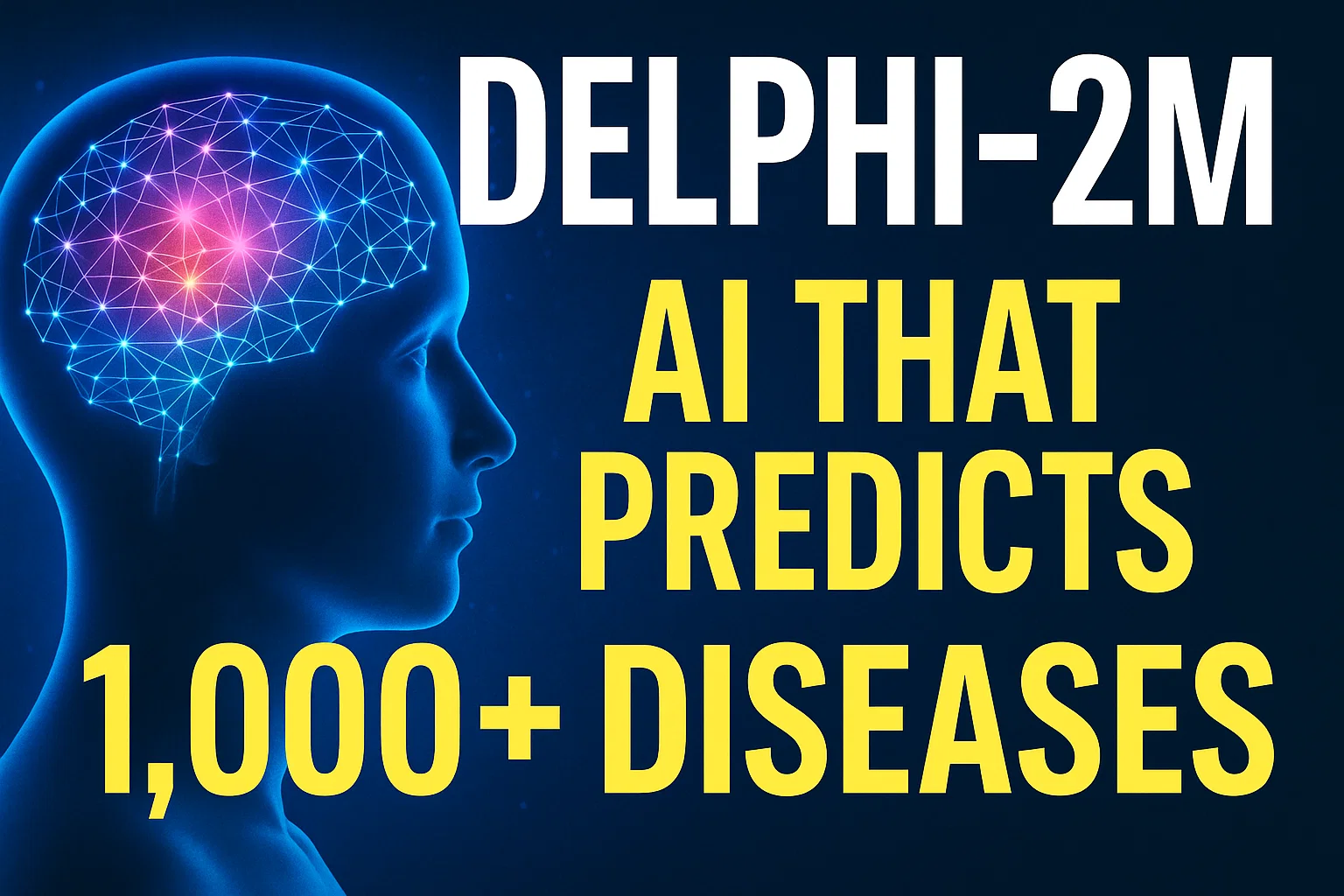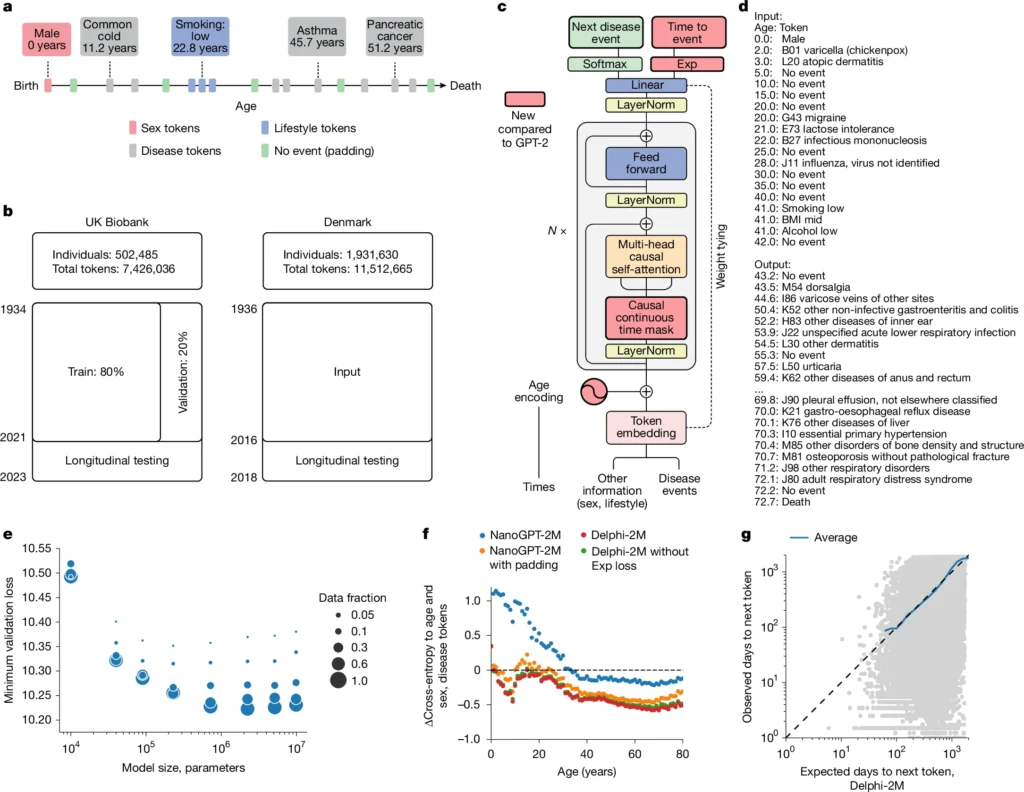Delphi-2M: New AI That Reveals Your Health Risks Decades in Advance — Here’s What It Found

London / Sept. 20, 2025 — European researchers have unveiled Delphi-2M, a generative transformer-based AI system that can predict an individual’s risk of developing more than 1,000 diseases over the next 10 to 20 years.
Trained on thousands of anonymized health records, the model aims to transform preventive medicine — but experts caution it’s still years away from ordinary clinical use.
What Is Delphi-2M and How It Works
Delphi-2M was developed by teams at the European Molecular Biology Laboratory (EMBL), the German Cancer Research Centre (DKFZ), University of Copenhagen, and other collaborators. It uses a modified large-language-model architecture (similar in some respects to those powering ChatGPT) to learn patterns from past medical history, lifestyle factors, demographics, and other risk influences.

Key facts:
- Training Data: 400,000 participants from the UK Biobank.
- Validation Data: 1.9 million individuals in Denmark’s National Patient Registry.
- Number of Diseases Modeled: Over 1,000 ICD-10 top-level disease categories, covering a wide range of conditions including chronic diseases, cancers, cardiovascular disease, and respiratory illnesses.
- Forecast Horizon: The model can estimate disease risk up to 20 years into the future, depending on the quality of medical history.
- Performance: On average, the model achieved an AUC (Area Under Curve) of ~0.76 in internal testing. For many diseases, its prediction quality is close to or better than existing disease-specific tools like QRisk for cardiovascular risk. However, accuracy declines for less common conditions and over longer horizons.
Why This Is a Big Deal
Delphi-2M marks a turning point in how health risk prediction is conceived and built, for several reasons:
- Scalability: Until now, many risk calculators focus on one disease (e.g., heart disease, diabetes). Delphi-2M does over a thousand at once. That means instead of doctors running multiple separate tools, one tool could offer a broad health forecast (The Guardian).
- Cross-Population Testing: Validation on data from Denmark (a healthcare system quite different from the UK’s) shows that despite cultural, demographic, or system differences, the model still performs reasonably well. That gives promise for applicability in multiple high-income countries.
- Preventive Health & Public Policy: By providing long-term forecasts, Delphi-2M can help public health agencies anticipate disease burdens, allocate resources, and design early-intervention strategies. In places with aging populations (e.g. UK, Scandinavia, parts of Canada), that foresight could prove valuable.
- A New Benchmark for AI in Medicine: The underlying architecture introduces generative modeling of health trajectories over time — not just predicting risk of a single event but modelling how sequences of comorbidity unfold. This adds a level of temporal depth absent from many previous tools.
Also Read: What Exactly Is Moflin AI Pet? A Good Alternative to a Real Pet?
What Delphi-2M Is Not
Despite its power, Delphi-2M is not a catch-all, and there are significant caveats:
- Not a diagnostic tool yet: It does not replace medical advice. Its forecasts are probabilistic, not definitive. For many illnesses, environmental or unrecorded factors matter a lot.
- Bias & representation: The UK Biobank dataset is known to skew toward healthier, wealthier, less ethnically diverse populations. This means predictions may be less accurate for underrepresented groups. Accuracy also falls for rare diseases or those heavily influenced by lifestyle or environment not well captured in the training data.
- Ethical & privacy concerns: Use of such models raises questions about how this information will be used. Will insurers use it? Will health systems handle false positives or negatives responsibly? How will individuals consent, and what about data governance?
- Clinical integration takes time: To move from research to clinic, more validation is needed in diverse geographies. Integration into existing health systems, regulatory approval, and obtaining buy-in from medical professionals are nontrivial.
Global Perspective: Implications for Healthcare
- Healthcare systems under strain: Around the world, chronic diseases, aging populations, and rising healthcare costs are putting pressure on providers. A tool like Delphi-2M could shift more care toward prevention rather than treatment, reducing long-term costs and improving outcomes.
- Regulation and transparency: Any predictive health model must meet strong privacy and data-protection standards. Transparency about the data used, how predictions are generated, and how errors are addressed will be critical for trust and adoption.
- Equity in predictions: Predictive models trained on limited population datasets may not generalize well to diverse groups. Over- or under-estimating risk could have serious consequences, from unnecessary anxiety to missed early interventions. Ensuring fairness and inclusivity is key.
- Clinical vs consumer use: Adoption will likely begin in research settings, public health planning, and specialist clinics before moving into everyday primary care. Consumer apps may integrate similar predictive features, but accuracy and limitations must be clearly communicated.
- Ethics and responsible use: Access to risk predictions must be carefully managed to avoid discrimination or misuse, such as influencing insurance premiums or employment decisions. Ethical guidelines will be needed to protect individuals while maximizing public health benefits.
What’s Next: From Research to Real-World Use
The researchers behind Delphi-2M outline several steps forward:
- Integrate genomic / proteomic data: Much of the current work is based on health records + lifestyle + demographics. Future versions may add molecular biomarkers to improve accuracy, especially for diseases where genetics play a large role.
- Expand geographically: Testing in diverse populations outside UK and Denmark to check how well predictions hold up. Countries in Asia, Africa, Latin America may have different risk profiles.
- Improve explainability & fairness: The model already exposes biases and disease clusters via explainable AI methods. Further work is needed to ensure predictions are calibrated fairly across sex, age, ethnicity.
- Regulatory guidance & medical trials: Shifting from proof-of-concept to clinical trials will require regulatory oversight (e.g., EU’s MDR, FDA for U.S.) and evidence that using Delphi-2M results in better patient outcomes, not just risk prediction.
Also Read: Microsoft Azure Unveils the World’s Most Powerful AI Supercomputer and Its Global Network
A Journalist’s View: Why This Feels Like a Health Inflection Point
From what we see, Delphi-2M represents more than just incremental improvement. It embodies a shift: from reactive healthcare (responding to disease) toward anticipatory health. These are forecasts rather than diagnoses.
The utility lies in what you can do once you know your risk ahead of time — lifestyle changes, targeted screening, prioritization of public health resources — not just the knowledge itself.
But there’s a balance.
Public understanding matters: risk predictions can be misinterpreted or create anxiety. The value of Delphi-2M will depend heavily on how its insights are communicated to people and integrated into healthcare practice.
